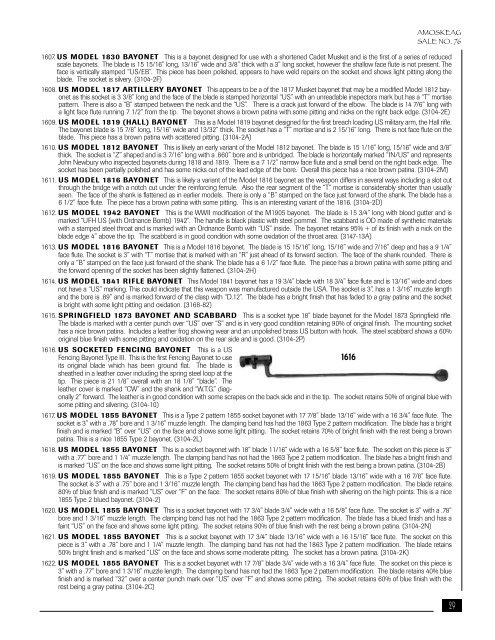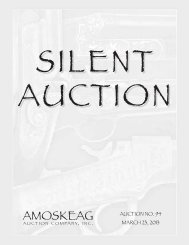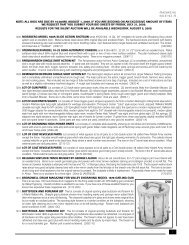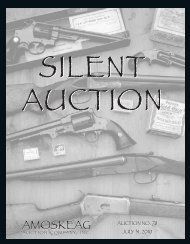AMOSKEAG AMOSKEAG - Amoskeag Auction Company
AMOSKEAG AMOSKEAG - Amoskeag Auction Company
AMOSKEAG AMOSKEAG - Amoskeag Auction Company
Create successful ePaper yourself
Turn your PDF publications into a flip-book with our unique Google optimized e-Paper software.
<strong>AMOSKEAG</strong><br />
SALE NO. 76<br />
1607. US MODEL 1830 BAYONET This is a bayonet designed for use with a shortened Cadet Musket and is the first of a series of reduced<br />
scale bayonets. The blade is 15 15/16” long, 13/16” wide and 3/8” thick with a 3” long socket, however the shallow face flute is not present. The<br />
face is vertically stamped “US/EB”. This piece has been polished, appears to have weld repairs on the socket and shows light pitting along the<br />
blade. The socket is silvery. (3104-2F)<br />
1608. US MODEL 1817 ARTILLERY BAYONET This appears to be a of the 1817 Musket bayonet that may be a modified Model 1812 bayonet<br />
as this socket is 3 3/8” long and the face of the blade is stamped horizontal “US” with an unreadable inspectors mark but has a “T” mortise<br />
pattern. There is also a “B” stamped between the neck and the “US”. There is a crack just forward of the elbow. The blade is 14 7/6” long with<br />
a light face flute running 7 1/2” from the tip. The bayonet shows a brown patina with some pitting and nicks on the right back edge. (3104-2E)<br />
1609. US MODEL 1819 (HALL) BAYONET This is a Model 1819 bayonet designed for the first breach loading US military arm, the Hall rifle.<br />
The bayonet blade is 15 7/8” long, 15/16” wide and 13/32” thick. The socket has a “T” mortise and is 2 15/16” long. There is not face flute on the<br />
blade. This piece has a brown patina with scattered pitting. (3104-2A)<br />
1610. US MODEL 1812 BAYONET This is likely an early variant of the Model 1812 bayonet. The blade is 15 1/16” long, 15/16” wide and 3/8”<br />
thick. The socket is “Z” shaped and is 3 7/16” long with a .860” bore and is unbridged. The blade is horizontally marked “IN/US” and represents<br />
John Newbury who inspected bayonets during 1818 and 1819. There is a 7 1/2” narrow face flute and a small bend on the right back edge. The<br />
socket has been partially polished and has some nicks out of the lead edge of the bore. Overall this piece has a nice brown patina. (3104-2M)<br />
1611. US MODEL 1816 BAYONET This is likely a variant of the Model 1816 bayonet as the weapon differs in several ways including a slot cut<br />
through the bridge with a notch cut under the reinforcing ferrule. Also the rear segment of the “T” mortise is considerably shorter than usually<br />
seen. The face of the shank is flattened as in earlier models. There is only a “B” stamped on the face just forward of the shank. The blade has a<br />
6 1/2” face flute. The piece has a brown patina with some pitting. This is an interesting variant of the 1816. (3104-2D)<br />
1612. US MODEL 1942 BAYONET This is the WWII modification of the M1905 bayonet. The blade is 15 3/4” long with blood gutter and is<br />
marked “UFH US (with Ordnance Bomb) 1942”. The handle is black plastic with steel pommel. The scabbard is OD made of synthetic materials<br />
with a stamped steel throat and is marked with an Ordnance Bomb with “US” inside. The bayonet retains 95% + of its finish with a nick on the<br />
blade edge 4” above the tip. The scabbard is in good condition with some oxidation of the throat area. (3147-13A)<br />
1613. US MODEL 1816 BAYONET This is a Model 1816 bayonet. The blade is 15 15/16” long, 15/16” wide and 7/16” deep and has a 9 1/4”<br />
face flute. The socket is 3” with “T” mortise that is marked with an “R” just ahead of its forward section. The face of the shank rounded. There is<br />
only a “B” stamped on the face just forward of the shank. The blade has a 6 1/2” face flute. The piece has a brown patina with some pitting and<br />
the forward opening of the socket has been slightly flattened. (3104-2H)<br />
1614. US MODEL 1841 RIFLE BAYONET This Model 1841 bayonet has a 19 3/4” blade with 18 3/4” face flute and is 13/16” wide and does<br />
not have a “US” marking. This could indicate that this weapon was manufactured outside the USA. The socket is 3”, has a 1 3/16” muzzle length<br />
and the bore is .89” and is marked forward of the clasp with “D.12”. The blade has a bright finish that has faded to a gray patina and the socket<br />
is bright with some light pitting and oxidation. (3168-82)<br />
1615. SPRINGFIELD 1873 BAYONET AND SCABBARD This is a socket type 18” blade bayonet for the Model 1873 Springfield rifle.<br />
The blade is marked with a center punch over “US” over “S” and is in very good condition retaining 90% of original finish. The mounting socket<br />
has a nice brown patina. Includes a leather frog showing wear and an unpolished brass US button with hook. The steel scabbard shows a 60%<br />
original blue finish with some pitting and oxidation on the rear side and is good. (3104-2P)<br />
1616. US SOCKETED FENCING BAYONET This is a US<br />
Fencing Bayonet Type III. This is the first Fencing Bayonet to use<br />
1616<br />
its original blade which has been ground flat. The blade is<br />
sheathed in a leather cover including the spring steel loop at the<br />
tip. This piece is 21 1/8” overall with an 18 1/8” “blade”. The<br />
leather cover is marked “CW” and the shank and “W.T.G.” diagonally<br />
2” forward. The leather is in good condition with some scrapes on the back side and in the tip. The socket retains 50% of original blue with<br />
some pitting and silvering. (3104-10)<br />
1617. US MODEL 1855 BAYONET This is a Type 2 pattern 1855 socket bayonet with 17 7/8” blade 13/16” wide with a 16 3/4” face flute. The<br />
socket is 3” with a .78” bore and 1 3/16” muzzle length. The clamping band has had the 1863 Type 2 pattern modification. The blade has a bright<br />
finish and is marked “B” over “US” on the face and shows some light pitting. The socket retains 70% of bright finish with the rest being a brown<br />
patina. This is a nice 1855 Type 2 bayonet. (3104-2L)<br />
1618. US MODEL 1855 BAYONET This is a socket bayonet with 18” blade 11/16” wide with a 16 5/8” face flute. The socket on this piece is 3”<br />
with a .77” bore and 1 1/4” muzzle length. The clamping band has not had the 1863 Type 2 pattern modification. The blade has a bright finish and<br />
is marked “US” on the face and shows some light pitting. The socket retains 50% of bright finish with the rest being a brown patina. (3104-2B)<br />
1619. US MODEL 1855 BAYONET This is a Type 2 pattern 1855 socket bayonet with 17 15/16” blade 13/16” wide with a 16 7/8” face flute.<br />
The socket is 3” with a .75” bore and 1 3/16” muzzle length. The clamping band has had the 1863 Type 2 pattern modification. The blade retains<br />
80% of blue finish and is marked “US” over “F” on the face. The socket retains 80% of blue finish with silvering on the high points. This is a nice<br />
1855 Type 2 blued bayonet. (3104-2)<br />
1620. US MODEL 1855 BAYONET This is a socket bayonet with 17 3/4” blade 3/4” wide with a 16 5/8” face flute. The socket is 3” with a .78”<br />
bore and 1 3/16” muzzle length. The clamping band has not had the 1863 Type 2 pattern modification. The blade has a blued finish and has a<br />
faint “US” on the face and shows some light pitting. The socket retains 90% of blue finish with the rest being a brown patina. (3104-2N)<br />
1621. US MODEL 1855 BAYONET This is a socket bayonet with 17 3/4” blade 13/16” wide with a 16 15/16” face flute. The socket on this<br />
piece is 3” with a .78” bore and 1 1/4” muzzle length. The clamping band has not had the 1863 Type 2 pattern modification. The blade retains<br />
50% bright finish and is marked “US” on the face and shows some moderate pitting. The socket has a brown patina. (3104-2K)<br />
1622. US MODEL 1855 BAYONET This is a socket bayonet with 17 7/8” blade 3/4” wide with a 16 3/4” face flute. The socket on this piece is<br />
3” with a .77” bore and 1 3/16” muzzle length. The clamping band has not had the 1863 Type 2 pattern modification. The blade retains 40% blue<br />
finish and is marked “32” over a center punch mark over “US” over “F” and shows some pitting. The socket retains 60% of blue finish with the<br />
rest being a gray patina. (3104-2C)<br />
29






